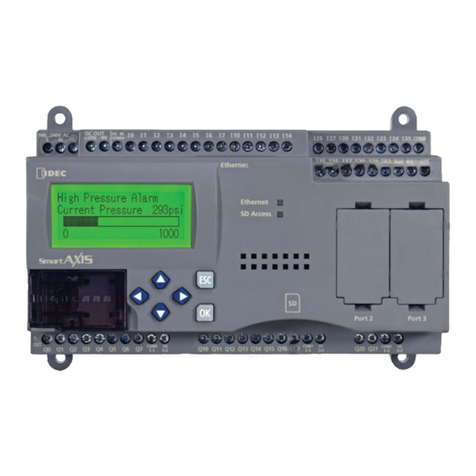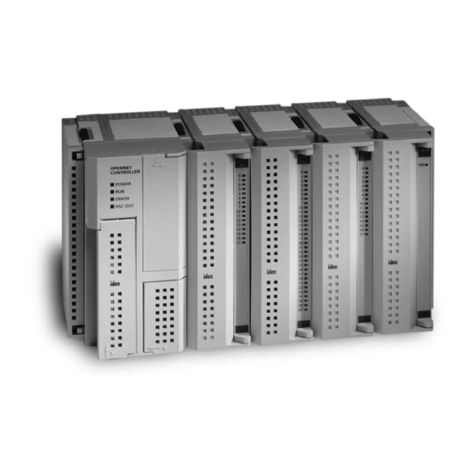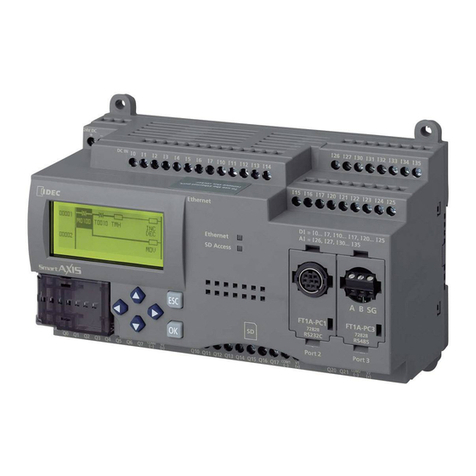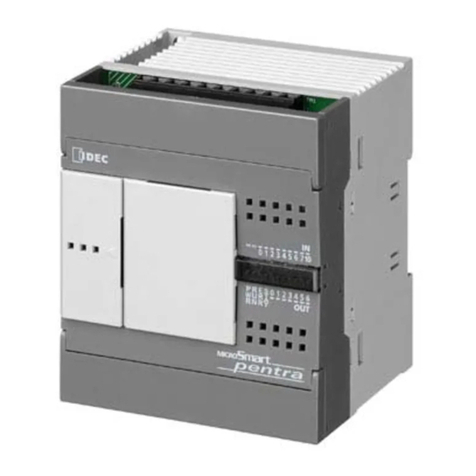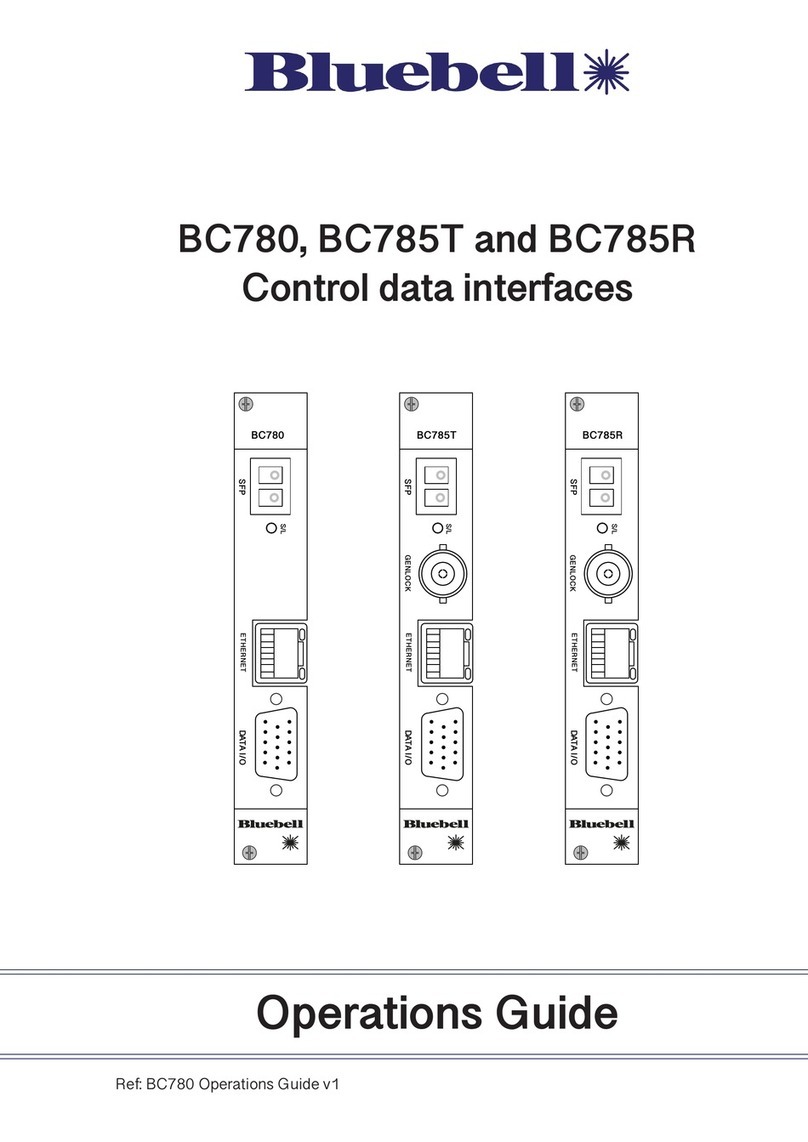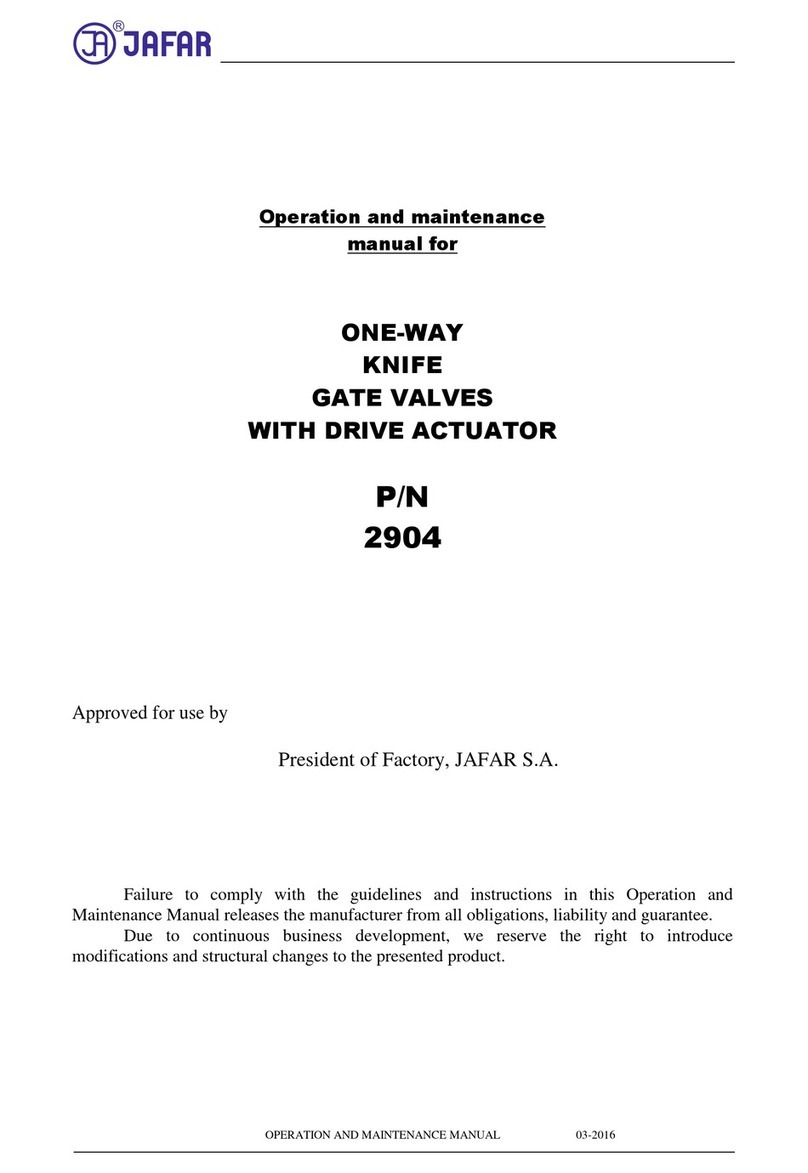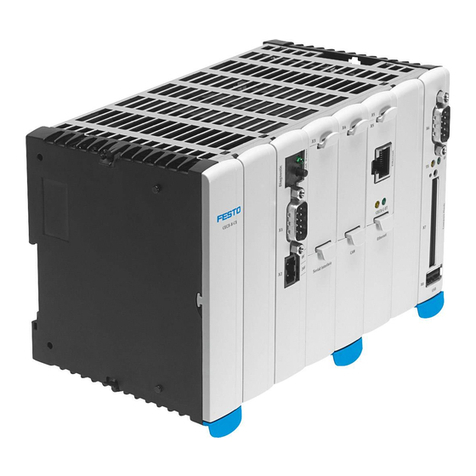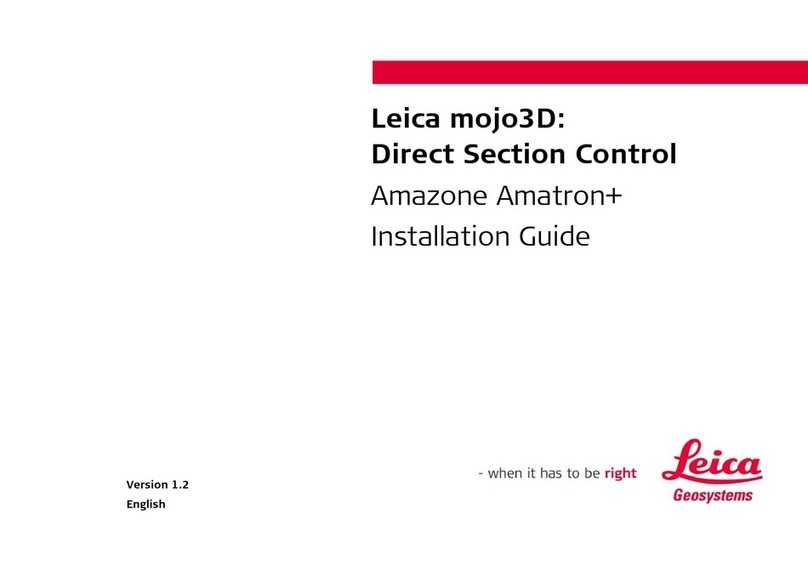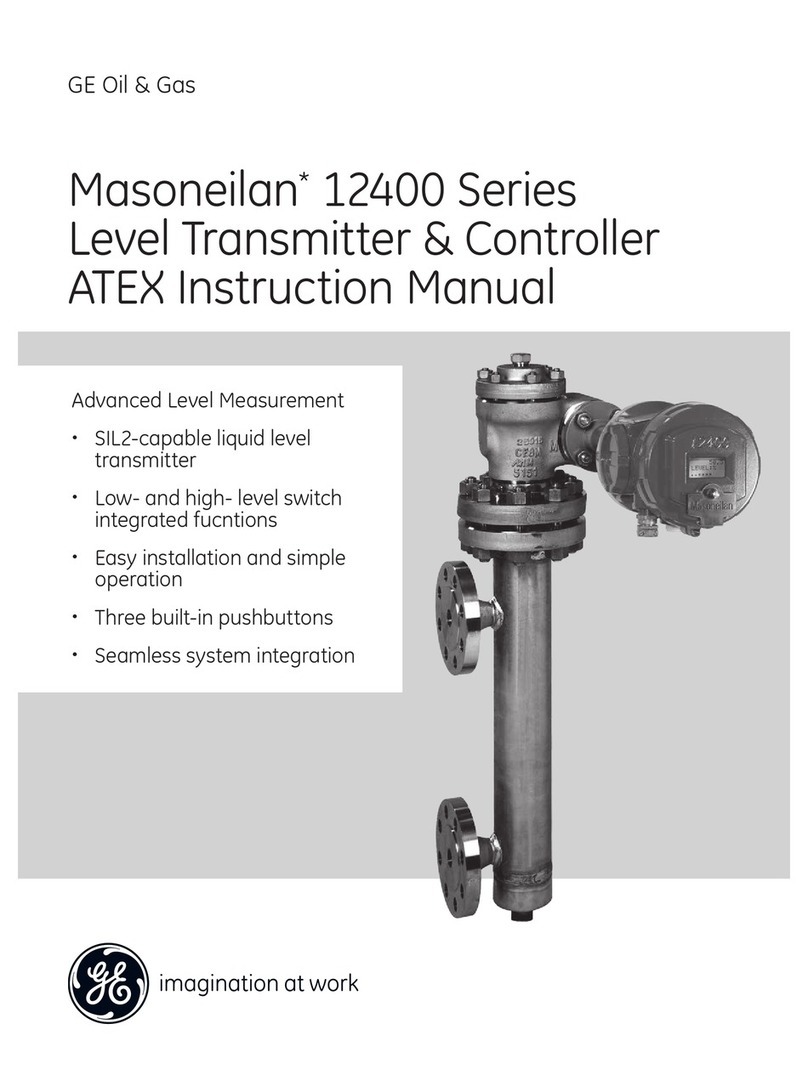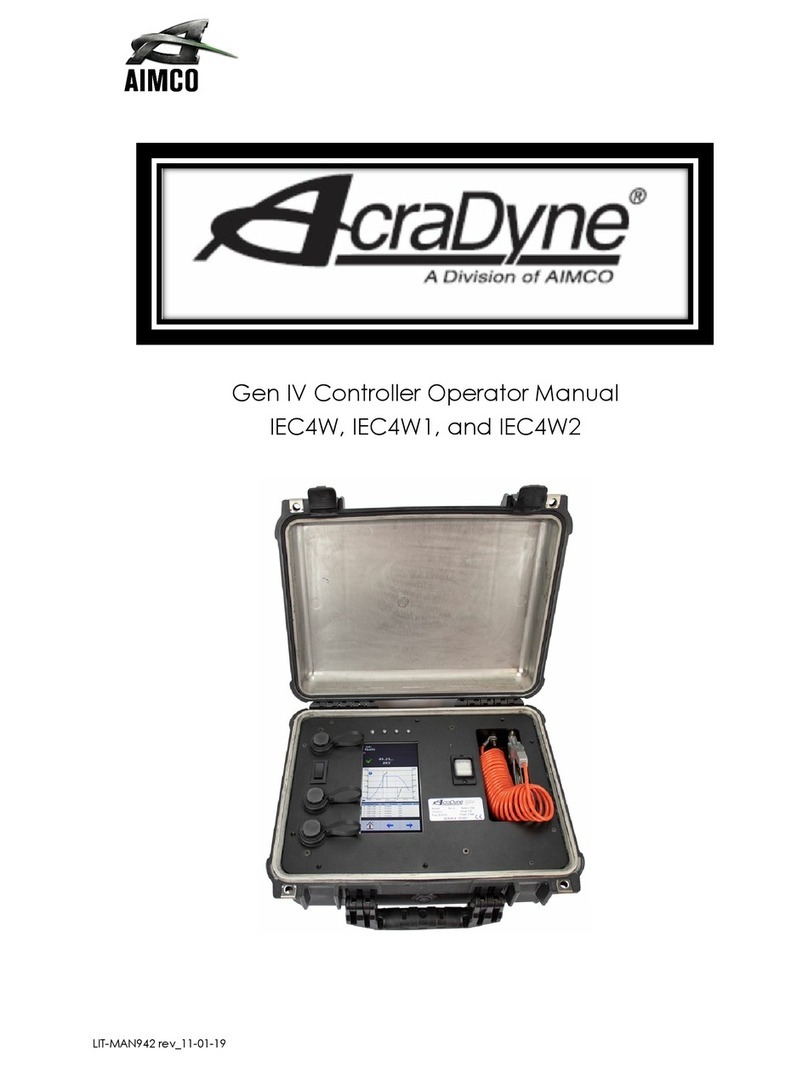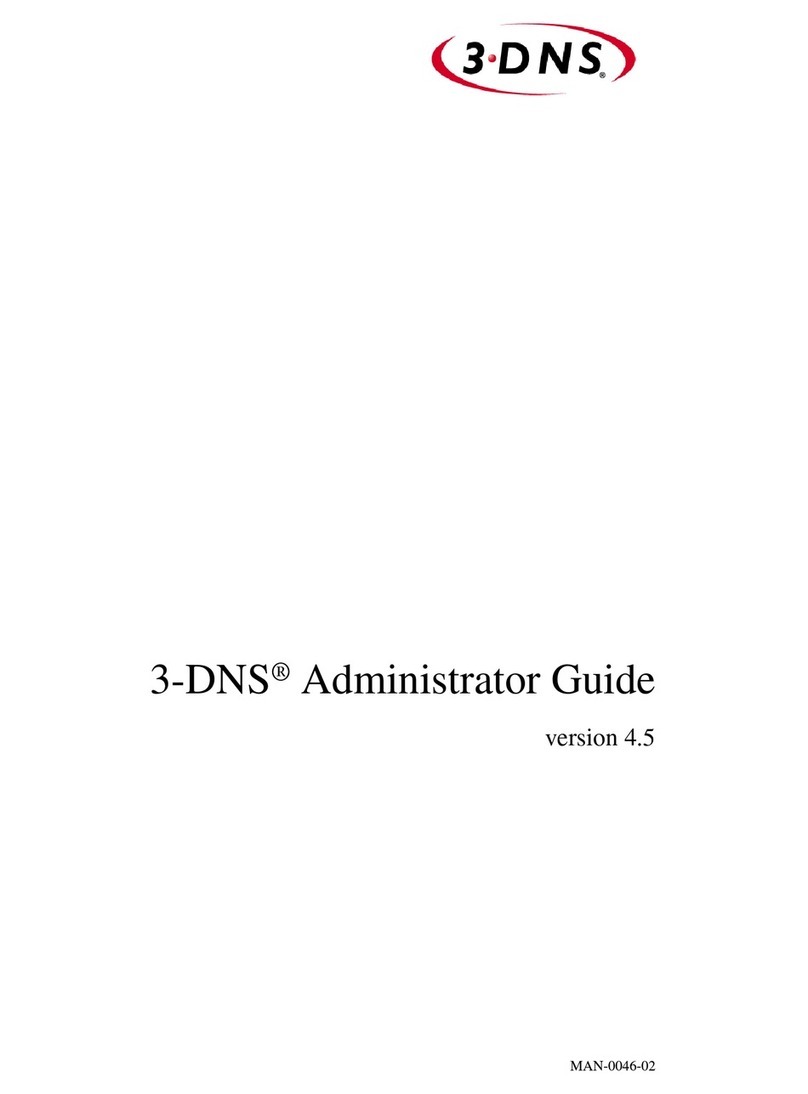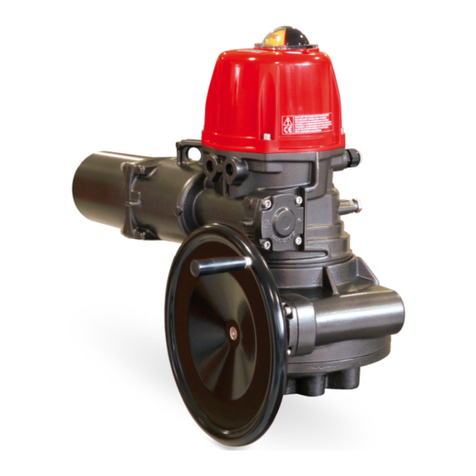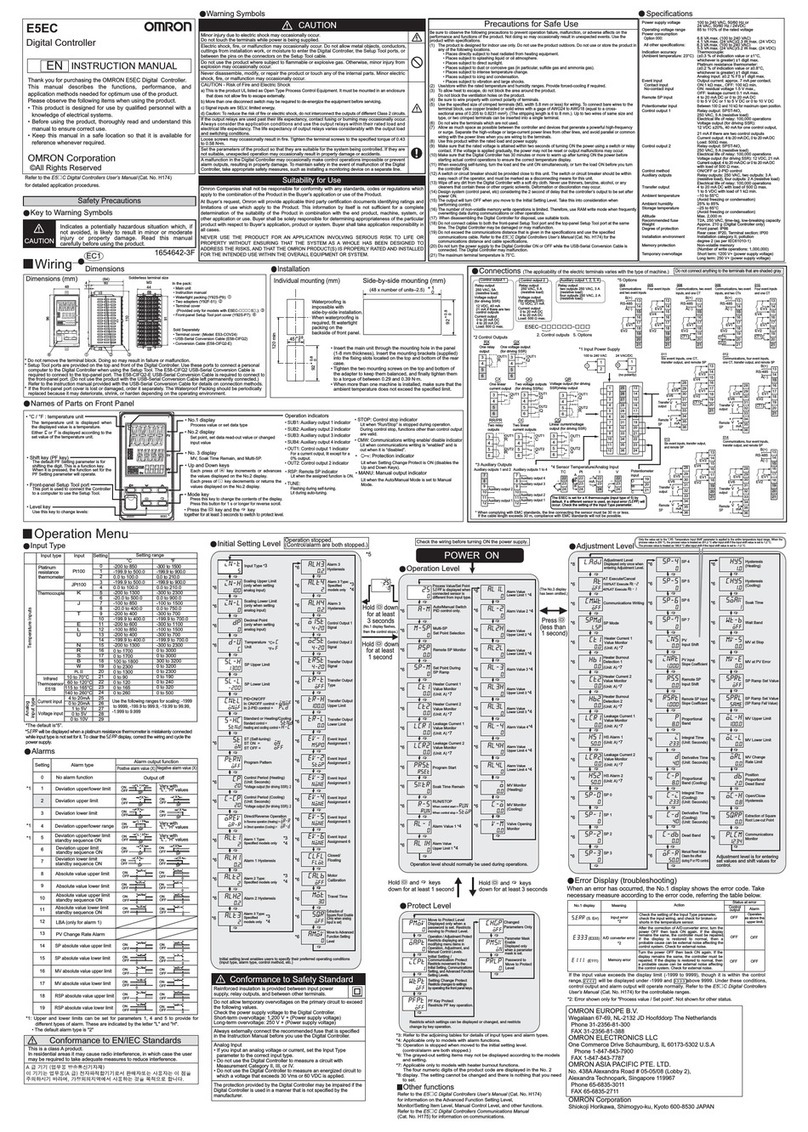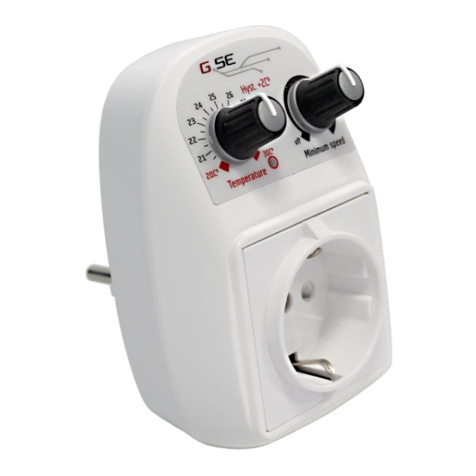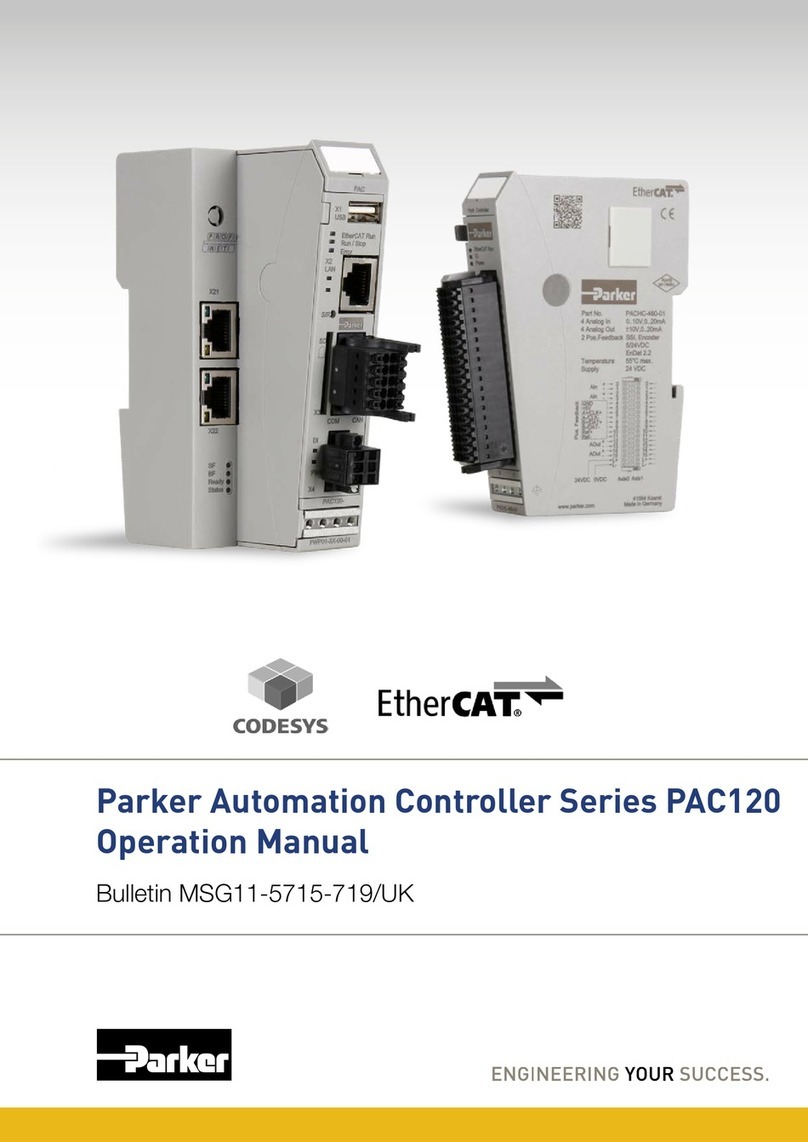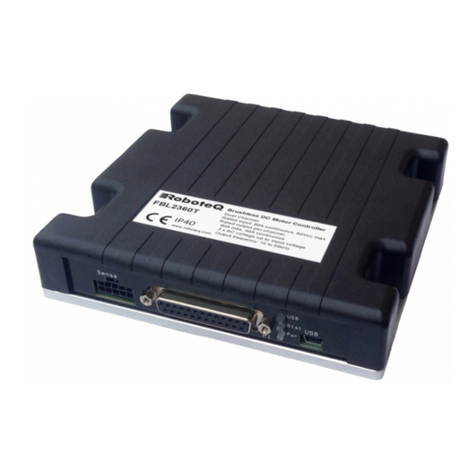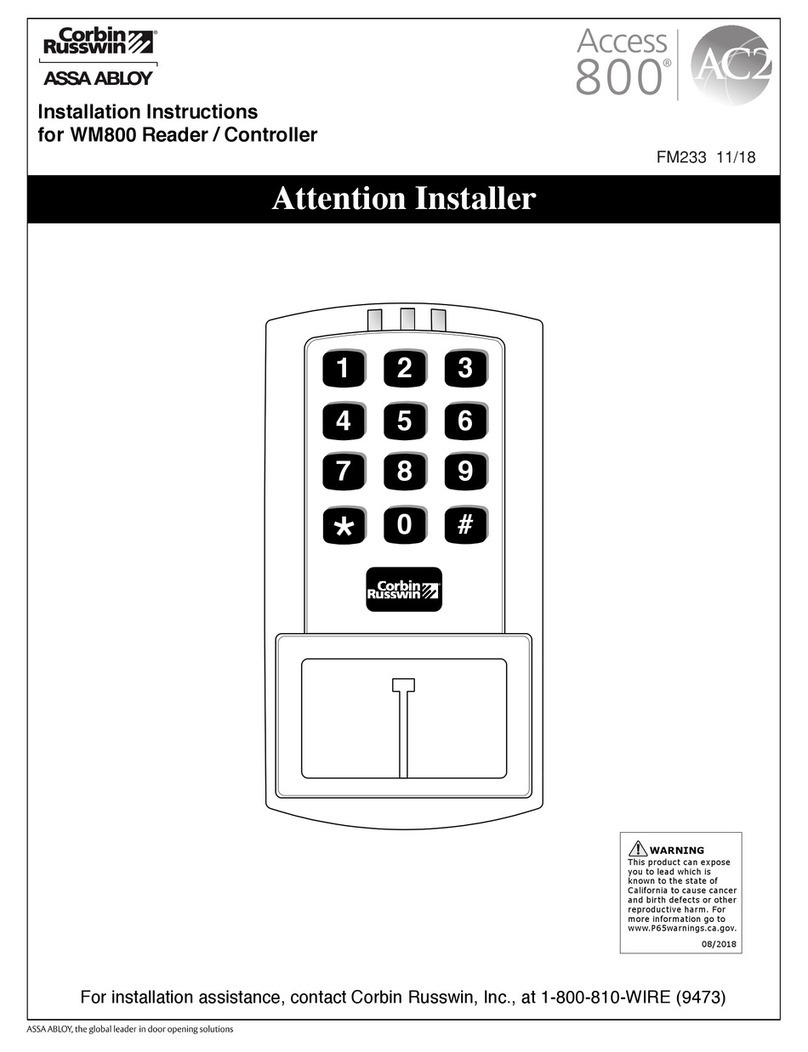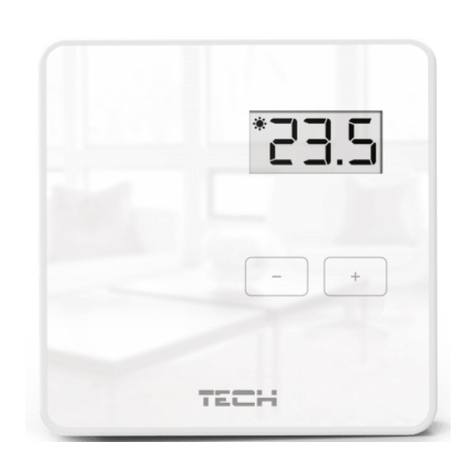IDEC microsmart pentra Owner's manual

FT1A SERIES
FC9Y-B1382
Ladder Programming Manual

FT1A S
MART
A
XIS
U
SER
’
S
M
ANUAL
FT9Y-B1382 Preface-1
SAFETY PRECAUTIONS
Read the FT1A Series Pro/Lite User’s Manual to make sure of correct operation before starting installation, wiring, operation, maintenance, and
inspection of the SmartAxis.
All SmartAxis modules are manufactured under IDEC’s rigorous quality control system, but users must add a backup or failsafe provision to the
control system when using the SmartAxis in applications where heavy damage or personal injury may be caused in case the SmartAxis should
fail.
In this user’s manual, safety precautions are categorized in order of importance to Warning and Caution:
The SmartAxis is not designed for use in medical equipment, nuclear power, railways, aviation, passenger vehicle equipment, or similar
applications requiring a high degree of reliability and safety. The SmartAxis cannot be used for such applications.
When using the SmartAxis in applications not described above that require a high degree of reliability in terms of functionality and precision,
appropriate measures such as failsafe mechanisms and redundant mechanisms must be taken for the system containing the SmartAxis.
Emergency stop and interlocking circuits must be configured outside the SmartAxis.
If relays or transistors in the SmartAxis output circuits should fail, outputs may remain at on or off state. For output signals which may cause
serious accidents, configure monitor circuits outside the SmartAxis.
The SmartAxis self-diagnostic function may detect internal circuit or program errors, stop programs, and turn outputs off. Configure circuits so
that the system containing the SmartAxis is not jeopardized when outputs turn off.
Turn off power to the SmartAxis before installation, removal, wiring, maintenance, and inspection of the SmartAxis. Failure to turn power off
may cause electrical shocks or fire hazard.
Special expertise is required to install, wire, program, and operate the SmartAxis. People without such expertise must not use the SmartAxis.
Install the SmartAxis according to the instructions described in FT1A series Pro/Lite user's manual. Improper installation will result in falling,
failure, or malfunction of the SmartAxis.
The SmartAxis is designed for installation in a cabinet. Do not install the SmartAxis outside a cabinet.
Install the SmartAxis in environments described in FT1A series Pro/Lite user's manual. If the SmartAxis is used in places where the SmartAxis is
subjected to high-temperature, high-humidity, condensation, corrosive gases, excessive vibrations, and excessive shocks, then electrical shocks,
fire hazard, or malfunction will result.
The environment for using the SmartAxis is “Pollution degree 2.” Use the SmartAxis in environments of pollution degree 2 (according to IEC
60664-1).
Prevent the SmartAxis from falling while moving or transporting the SmartAxis, otherwise damage or malfunction of the SmartAxis will result.
Wiring must use lead sizes that are appropriate for the applied voltage and current. Terminal screws must be tightened with the prescribed
tightening torque.
Prevent metal fragments and pieces of wire from dropping inside the SmartAxis housing. Put a cover on the SmartAxis modules during
installation and wiring. Ingress of such fragments and chips may cause fire hazard, damage, or malfunction.
Use a power supply of the rated value. Use of a wrong power supply may cause fire hazard.
Use an IEC 60127-approved fuse on the power line outside the SmartAxis. This is required when equipment containing the SmartAxis is destined
for Europe.
Use an IEC 60127-approved fuse on the output circuit. This is required when equipment containing the SmartAxis is destined for Europe.
Use an EU-approved circuit breaker. This is required when equipment containing the SmartAxis is destined for Europe.
Make sure of safety before starting and stopping the SmartAxis or when operating the SmartAxis to force outputs on or off. Incorrect operation
on the SmartAxis may cause machine damage or accidents.
Do not connect the ground wire directly to the SmartAxis. Connect a protective ground to the cabinet containing the SmartAxis using an M4 or
larger screw. This is required when equipment containing the SmartAxis is destined for Europe.
Do not disassemble, repair, or modify the SmartAxis modules.
The SmartAxis contains electronic parts and batteries. When disposing of the SmartAxis, do so in accordance with
national and local regulations.
Warning notices are used to emphasize that improper operation may cause severe personal injury or death.
Warning
Caution notices are used where inattention might cause personal injury or damage to equipment.
Caution

Preface-2 FT1A S
MART
A
XIS
U
SER
’
S
M
ANUAL
FT9Y-B1382
About This Manual
This user’s manual describes basic and advanced instructions and the usage of software for SmartAxis ladder programming.
Chapter 1: Operation Basics
General information about simple operating procedures from creating a user program using WindLDR on a PC to monitoring the
SmartAxis operation.
Chapter 3: Device Addresses
Device addresses available for the SmartAxis CPU modules to program basic and advanced instructions. Special internal relays and
special data registers are also described.
Chapter 4: Instructions Reference
List of all basic and advanced instructions and general rules of using advanced instructions, terms, data types, and formats used
for advanced instructions.
Chapter 5: Basic Instructions
Programming of the basic instructions, available devices, and sample programs.
Chapter 6 through Chapter 26:
Detailed descriptions on advanced instructions.
Appendix
Additional information about execution times and size for instructions.
Index
Alphabetical listing of key words.
Publication history
October 2012 First Edition
Trademarks
SmartAxis is a trademark of IDEC Corporation.
IMPORTANT INFORMATION
Under no circumstances shall IDEC Corporation be held liable or responsible for indirect or consequential damages resulting from
the use of or the application of IDEC PLC components, individually or in combination with other equipment.
All persons using these components must be willing to accept responsibility for choosing the correct component to suit their
application and for choosing an application appropriate for the component, individually or in combination with other equipment.
All diagrams and examples in this manual are for illustrative purposes only. In no way does including these diagrams and
examples in this manual constitute a guarantee as to their suitability for any specific application. To test and approve all
programs, prior to installation, is the responsibility of the end user.

FT1A S
MART
A
XIS
U
SER
’
S
M
ANUAL
FT9Y-B1382 Preface-3
RELATED MANUALS
The following manuals related to the SmartAxis are available. Refer to them in conjunction with this manual.
Type No. Manual Name Description
FT9Y-B1378 FT1A Series Pro/Lite
User’s Manual
Describes product specifications, installation and wiring instructions, instructions for
basic programming operations and special functions, device and instruction lists,
communication functions, and troubleshooting procedures for the SmartAxis Pro/Lite
series.
FT9Y-B1382
FT1A Series
Ladder Programming Manual
(this manual)
Describes basic operations for ladder programming, instructions for editing and
monitoring ladders on the SmartAxis, available devices and instruction lists, and
details of each instruction.
FT9Y-B1390 FT1A Series Touch
User’s Manual
Describes product specifications, installation and wiring instructions, instructions for
setting basic programming actions and special functions, device and instruction lists,
communication functions, and troubleshooting procedures for the Touch series.
WindLDR Help Describes usage instructions for WindLDR, programming software for the SmartAxis
Pro/Lite series.
WindO/I-NV3 Help Describes programming for the SmartAxis Touch series, and usage instructions for
the WindO/I-NV3 configuration software.

Preface-4 FT1A S
MART
A
XIS
U
SER
’
S
M
ANUAL
FT9Y-B1382
NAMES AND ABBREVIATIONS USED IN THIS MANUAL
Model Names
Name Used in this Manual Description (Detailed Type No.)
SmartAxis Name for the FT1A programmable logic controllers.
SmartAxis Lite
General name for modules with no LCD.
(FT1A-B12RA, FT1A-B12RC, FT1A-B24RA, FT1A-B24RC, FT1A-B40RKA, FT1A-B40RSA, FT1A-B40RC,
FT1A-B48KA, FT1A-B48SA, FT1A-B48KC, FT1A-B48SC)
SmartAxis Pro
General name for modules with LCD.
(FT1A-H12RA, FT1A-H12RC, FT1A-H24RA, FT1A-H24RC, FT1A-H40RKA, FT1A-H40RSA, FT1A-H40RC,
FT1A-H48KA, FT1A-H48SA, FT1A-H48KC, FT1A-H48SC)
SmartAxis Touch General name for modules that extend the functionality of display.
(FT1A-M12RA-W, FT1A-M12RA-B, FT1A-M12RA-S, FT1A-C12RA-W, FT1A-C12RA-B, FT1A-C12RA-S)
12-I/O type General name for SmartAxis Pro and Lite models with 12 I/O points.
(FT1A-B12RA, FT1A-B12RC, FT1A-H12RA, FT1A-H12RC)
24-I/O type General name for SmartAxis Pro and Lite models with 24 I/O points.
(FT1A-B24RA, FT1A-B24RC, FT1A-H24RA, FT1A-H24RC)
40-I/O type General name for SmartAxis Pro and Lite models with 40 I/O points.
(FT1A-B40RKA, FT1A-B40RSA, FT1A-B40RC, FT1A-H40RKA, FT1A-H40RSA, FT1A-H40RC)
48-I/O type
General name for SmartAxis Pro and Lite models with 48 I/O points.
(FT1A-B48KA, FT1A-B48SA, FT1A-B48KC, FT1A-B48SC, FT1A-H48KA, FT1A-H48SA, FT1A-H48KC,
FT1A-H48SC)
AC power type
General name for SmartAxis Pro and Lite models with an AC power supply.
(FT1A-B12RC, FT1A-H12RC, FT1A-B24RC, FT1A-H24RC, FT1A-B40RC, FT1A-H40RC, FT1A-B48KC,
FT1A-B48SC, FT1A-H48KC, FT1A-H48SC)
DC power type
General name for SmartAxis Pro and Lite models with a DC power supply.
(FT1A-B12RA, FT1A-H12RA, FT1A-B24RA, FT1A-H24RA, FT1A-B40RKA, FT1A-H40RKA,
FT1A-B40RSA, FT1A-H40RSA, FT1A-B48KA, FT1A-B48SA, FT1A-H48KA, FT1A-H48SA)

Preface-5 FT1A S
MART
A
XIS
U
SER
’
S
M
ANUAL
FT9Y-B1382

FT1A S
MART
A
XIS
U
SER
’
S
M
ANUAL
FT9Y-B1382
I
TABLE OF CONTENTS
Safety Precautions............................................................................................................................. Preface-1
About This Manual.............................................................................................................................. Preface-2
Related Manuals................................................................................................................................ Preface-3
Names and Abbreviations Used in this Manual ..................................................................................... Preface-4
CHAPTER
1: Operation Basics
Start WindLDR ............................................................................................................................................1-1
PLC Selection ..............................................................................................................................................1-2
Create Ladder Program................................................................................................................................1-3
Save Project................................................................................................................................................1-6
Simulate Operation......................................................................................................................................1-7
Download Program ...................................................................................................................................... 1-7
Monitor Operation ....................................................................................................................................... 1-8
Quit WindLDR .............................................................................................................................................1-8
CHAPTER
3: Device Addresses
Device Addresses ........................................................................................................................................3-1
Special Internal Relays................................................................................................................................. 3-2
Special Data Registers ................................................................................................................................. 3-8
CHAPTER
4: Instructions Reference
Basic Instruction List....................................................................................................................................4-1
Advanced Instruction List.............................................................................................................................4-3
Advanced Instruction Applicable CPU Modules ...............................................................................................4-6
Structure of an Advanced Instruction ............................................................................................................ 4-9
Input Condition for Advanced Instructions..................................................................................................... 4-9
Source and Destination Devices....................................................................................................................4-9
Using Timer or Counter as Source Device......................................................................................................4-9
Using Timer or Counter as Destination Device ............................................................................................... 4-9
Data Types for Advanced Instructions......................................................................................................... 4-10
Discontinuity of Device Areas ..................................................................................................................... 4-14
NOP (No Operation) .................................................................................................................................. 4-14
CHAPTER
5: Basic Instructions
Basic Instruction List....................................................................................................................................5-1
LOD (Load) and LODN (Load Not) ................................................................................................................5-3
OUT (Output) and OUTN (Output Not)..........................................................................................................5-3
SET and RST (Reset) ...................................................................................................................................5-4
AND and ANDN (And Not)............................................................................................................................5-5
OR and ORN (Or Not) ..................................................................................................................................5-5
AND LOD (Load) ......................................................................................................................................... 5-6
OR LOD (Load) ........................................................................................................................................... 5-6
BPS (Bit Push), BRD (Bit Read), and BPP (Bit Pop).........................................................................................5-7
TML, TIM, TMH, and TMS (Timer) ................................................................................................................ 5-8
TMLO, TIMO, TMHO, and TMSO (Off-Delay Timer) ...................................................................................... 5-11
CNT, CDP, and CUD (Counter).................................................................................................................... 5-12
CNTD, CDPD, and CUDD (Double-Word Counter)......................................................................................... 5-15
CC= and CC≥(Counter Comparison) .......................................................................................................... 5-19
DC= and DC≥(Data Register Comparison) ................................................................................................. 5-21
SFR and SFRN (Forward and Reverse Shift Register).................................................................................... 5-23
SOTU and SOTD (Single Output Up and Down) ........................................................................................... 5-27
MCS and MCR (Master Control Set and Reset) ............................................................................................. 5-28
JMP (Jump) and JEND (Jump End) ............................................................................................................. 5-30
END ......................................................................................................................................................... 5-31
Restriction on Ladder Programming ............................................................................................................ 5-32
CHAPTER
6: Move Instructions
MOV (Move)................................................................................................................................................6-1

II
FT1A S
MART
A
XIS
U
SER
’
S
M
ANUAL
FT9Y-B1382
MOVN (Move Not)....................................................................................................................................... 6-5
IMOV (Indirect Move).................................................................................................................................. 6-6
IMOVN (Indirect Move Not) ......................................................................................................................... 6-8
BMOV (Block Move) .................................................................................................................................... 6-9
IBMV (Indirect Bit Move) ............................................................................................................................6-10
IBMVN (Indirect Bit Move Not)....................................................................................................................6-12
NSET (N Data Set) .....................................................................................................................................6-13
NRS (N Data Repeat Set)............................................................................................................................6-14
XCHG (Exchange) ......................................................................................................................................6-15
TCCST (Timer/Counter Current Value Store) ................................................................................................6-16
CHAPTER
7: Data Comparison Instructions
CMP= (Compare Equal To) .......................................................................................................................... 7-1
CMP<> (Compare Unequal To).................................................................................................................... 7-1
CMP< (Compare Less Than) ........................................................................................................................ 7-1
CMP> (Compare Greater Than).................................................................................................................... 7-1
CMP<= (Compare Less Than or Equal To) .................................................................................................... 7-1
CMP>= (Compare Greater Than or Equal To) ............................................................................................... 7-1
ICMP>= (Interval Compare Greater Than or Equal To).................................................................................. 7-6
LC= (Load Compare Equal To)..................................................................................................................... 7-8
LC<> (Load Compare Unequal To) .............................................................................................................. 7-8
LC< (Load Compare Less Than)................................................................................................................... 7-8
LC> (Load Compare Greater Than) .............................................................................................................. 7-8
LC<= (Load Compare Less Than or Equal To)............................................................................................... 7-8
LC>= (Load Compare Greater Than or Equal To) .......................................................................................... 7-8
CHAPTER
8: Binary Arithmetic Instructions
ADD (Addition) ........................................................................................................................................... 8-1
SUB (Subtraction) ....................................................................................................................................... 8-1
MUL (Multiplication) .................................................................................................................................... 8-1
DIV (Division) ............................................................................................................................................. 8-1
INC (Increment) ........................................................................................................................................8-13
DEC (Decrement).......................................................................................................................................8-13
ROOT (Root) .............................................................................................................................................8-14
SUM (Sum)................................................................................................................................................8-15
CHAPTER
9: Boolean Computation Instructions
ANDW (AND Word) ..................................................................................................................................... 9-1
ORW (OR Word) ......................................................................................................................................... 9-1
XORW (Exclusive OR Word) ......................................................................................................................... 9-1
CHAPTER
10: Shift / Rotate Instructions
SFTL (Shift Left) ........................................................................................................................................10-1
SFTR (Shift Right)......................................................................................................................................10-3
BCDLS (BCD Left Shift)...............................................................................................................................10-5
WSFT (Word Shift).....................................................................................................................................10-7
ROTL (Rotate Left).....................................................................................................................................10-8
ROTR (Rotate Right) ................................................................................................................................10-10
CHAPTER
11: Data Conversion Instructions
HTOB (Hex to BCD) ...................................................................................................................................11-1
BTOH (BCD to Hex) ...................................................................................................................................11-3
HTOA (Hex to ASCII) .................................................................................................................................11-5
ATOH (ASCII to Hex) .................................................................................................................................11-7
BTOA (BCD to ASCII) .................................................................................................................................11-9
ATOB (ASCII to BCD) ...............................................................................................................................11-12
ENCO (Encode)........................................................................................................................................11-15
DECO (Decode) .......................................................................................................................................11-16
BCNT (Bit Count) .....................................................................................................................................11-17
ALT (Alternate Output).............................................................................................................................11-18

FT1A S
MART
A
XIS
U
SER
’
S
M
ANUAL
FT9Y-B1382
III
CVDT (Convert Data Type)....................................................................................................................... 11-19
DTDV (Data Divide) ................................................................................................................................. 11-21
DTCB (Data Combine) ............................................................................................................................. 11-22
SWAP (Data Swap).................................................................................................................................. 11-23
CHAPTER
12: Calendar Comparison Instructions
WEEK (Weekly Timer)................................................................................................................................ 12-1
YEAR (Yearly Timer) ................................................................................................................................ 12-11
CHAPTER
14: Program Branching Instructions
LABEL (Label) ........................................................................................................................................... 14-1
LJMP (Label Jump) .................................................................................................................................... 14-1
LCAL (Label Call) ....................................................................................................................................... 14-3
LRET (Label Return) .................................................................................................................................. 14-3
DJNZ (Decrement Jump Non-zero) ............................................................................................................. 14-5
CHAPTER
15: Refresh Instructions
IOREF (I/O Refresh) .................................................................................................................................. 15-1
HSCRF (High-speed Counter Refresh) ......................................................................................................... 15-3
CHAPTER
16: Interrupt Control Instructions
DI (Disable Interrupt) ................................................................................................................................ 16-1
EI (Enable Interrupt) ................................................................................................................................. 16-1
CHAPTER
17: Coordinate Conversion Instructions
XYFS (XY Format Set) ................................................................................................................................ 17-1
CVXTY (Convert X to Y) ............................................................................................................................. 17-2
CVYTX (Convert Y to X) ............................................................................................................................. 17-3
CHAPTER
18: Average Instructions
AVRG (Average) ........................................................................................................................................ 18-1
CHAPTER
19: Pulse Output Instructions
PULS (Pulse Output) .................................................................................................................................. 19-1
PWM (Variable Duty Cycle Pulse Output)..................................................................................................... 19-8
RAMP (Trapezoidal Control) ..................................................................................................................... 19-15
ZRN (Zero Return)................................................................................................................................... 19-26
ARAMP (RAMP with Table) ....................................................................................................................... 19-32
CHAPTER
20: Dual / Teaching Timer Instructions
DTML (1-sec Dual Timer) ........................................................................................................................... 20-1
DTIM (100-ms Dual Timer) ........................................................................................................................ 20-1
DTMH (10-ms Dual Timer) ......................................................................................................................... 20-1
DTMS (1-ms Dual Timer) ........................................................................................................................... 20-1
TTIM (Teaching Timer) .............................................................................................................................. 20-3
CHAPTER
21: Trigonometric Function Instructions
RAD (Degree to Radian) ............................................................................................................................ 21-1
DEG (Radian to Degree) ............................................................................................................................ 21-2
SIN (Sine)................................................................................................................................................. 21-3
COS (Cosine) ............................................................................................................................................ 21-4
TAN (Tangent) .......................................................................................................................................... 21-5
ASIN (Arc Sine) ......................................................................................................................................... 21-6
ACOS (Arc Cosine)..................................................................................................................................... 21-7
ATAN (Arc Tangent) .................................................................................................................................. 21-8
CHAPTER
22: Logarithm / Power Instructions
LOGE (Natural Logarithm) .......................................................................................................................... 22-1
LOG10 (Common Logarithm)...................................................................................................................... 22-2
EXP (Exponent) ......................................................................................................................................... 22-3
POW (Power) ............................................................................................................................................ 22-4

IV
FT1A S
MART
A
XIS
U
SER
’
S
M
ANUAL
FT9Y-B1382
CHAPTER
23: File Data Processing Instructions
FIFOF (FIFO Format)..................................................................................................................................23-1
FIEX (First-In Execute) ...............................................................................................................................23-3
FOEX (First-Out Execute)............................................................................................................................23-3
NDSRC (N Data Search) .............................................................................................................................23-5
CHAPTER
24: Clock Instructions
TADD (Time Addition) ................................................................................................................................24-1
TSUB (Time Subtraction) ............................................................................................................................24-5
HTOS (HMS to Sec)....................................................................................................................................24-9
STOH (Sec to HMS)..................................................................................................................................24-10
HOUR (Hour Meter) .................................................................................................................................24-11
CHAPTER
25: User Communication Instructions
TXD (Transmit)..........................................................................................................................................25-1
RXD (Receive) ...........................................................................................................................................25-7
ETXD (User Communication Transmit over Ethernet) ..................................................................................25-21
ERXD (User Communication Receive over Ethernet) ...................................................................................25-21
CHAPTER
26: Data Log Instructions
DLOG (Data Log) .......................................................................................................................................26-1
TRACE (Data Trace) ...................................................................................................................................26-8
APPENDIX
Execution Times for Instructions .................................................................................................................. A-1
Breakdown of END Processing Time ............................................................................................................. A-5
Instruction Bytes......................................................................................................................................... A-5
INDEX

FT1A S
MART
A
XIS
U
SER
’
S
M
ANUAL
FT9Y-B1382 1-1
1: OPERATION BASICS
Introduction
This chapter describes basic procedures for operating WindLDR, software required for programming and maintenance of the
SmartAxis Pro/Lite series.
Note: SmartAxis Touch series use WindO/I-NV3 for programming. See the “FT1A Series Touch User’s Manual” for instructions for programming and
basic operation of WindO/I-NV3 with the Touch series.
Start WindLDR
From the Start menu of Windows, select Programs > Automation Organizer > WindLDR > WindLDR.
WindLDR starts and a blank ladder editing screen appears with menus and tool bars shown on top of the screen.

1: O
PERATION
B
ASICS
1-2 FT1A S
MART
A
XIS
U
SER
’
S
M
ANUAL
FT9Y-B1382
PLC Selection
Before programming a user program on WindLDR, select a PLC type.
1. Select Configuration from the WindLDR menu bar, then select PLC Type.
The PLC Selection dialog box appears.
2. Select a PLC type in the selection box.
3. Click OK.
Press this button, then the same PLC will be selected
as default when WindLDR is started next time.
PLC Selection Option SmartAxis CPU Module
Type No.
FT1A-12
FT1A-24
FT1A-40
FT1A-48
FT1A-H12RA
FT1A-B12RA
FT1A-H12RC
FT1A-B12RC
FT1A-H24RA
FT1A-B24RA
FT1A-H24RC
FT1A-B24RC
FT1A-H40RKA
FT1A-H40RSA
FT1A-B40RKA
FT1A-B40RSA
FT1A-H40RC
FT1A-B40RC
FT1A-H48KA
FT1A-H48SA
FT1A-B48KA
FT1A-B48SA
FT1A-H48KC
FT1A-H48SC
FT1A-B48KC
FT1A-B48SC

FT1A S
MART
A
XIS
U
SER
’
S
M
ANUAL
FT9Y-B1382 1-3
1: O
PERATION
B
ASICS
Create Ladder Program
This section describes the procedure for creating a simple ladder program in WindLDR.
Note: See “INSTRUCTIONS REFERENCE” on page 4-1 for details on basic and advanced instructions.
Sample User Program
Create a simple program using WindLDR. The sample program performs the following operation:
When only input I0 is turned on, output Q0 is turned on.
When only input I1 is turned on, output Q1 is turned on.
When both inputs I0 and I1 are turned on, output Q2 flashes in 1-sec increments.
Note: One collection of a group of instructions that control output or advanced instructions is called a rung. WindLDR manages programs in rung
units. Function descriptions can be configured as rung comments for individual rungs.
Start WindLDR
From the Start menu of Windows, select Programs > Automation Organizer > WindLDR > WindLDR.
WindLDR starts and a blank ladder editing screen appears with menus and tool bars shown on top of the screen.
Rung No. Input I0 Input I1 Output Operation
1ON OFF Output Q0 is turned ON.
2OFF ON Output Q1 is turned ON.
3ON ON Output Q2 flashes in 1-sec increments.

1: O
PERATION
B
ASICS
1-4 FT1A S
MART
A
XIS
U
SER
’
S
M
ANUAL
FT9Y-B1382
Edit User Program Rung by Rung
Start the user program with the LOD instruction by inserting a NO contact of input I0.
1. From the WindLDR menu bar, select Home > Basic > A (Normally Open).
2. Move the mouse pointer to the first column of the first line where you want to insert a NO contact, and click the left mouse
button.
Note: Another method to insert a NO (or NC) contact is to move the mouse pointer where you want to insert the contact, and type A (or B).
The Normally Open dialog box appears.

FT1A S
MART
A
XIS
U
SER
’
S
M
ANUAL
FT9Y-B1382 1-5
1: O
PERATION
B
ASICS
3. Enter I0 in the Tag Name field, and click OK.
A NO contact of input I0 is programmed in the first column of the first ladder line.
Next, program the ANDN instruction by inserting a NC contact of input I1.
4. From the WindLDR menu bar, select Home > Basic > B (Normally Closed).
5. Move the mouse pointer to the second column of the first ladder line where you want to insert a NC contact, and click the left
mouse button.
The Normally Closed dialog box appears.
6. Enter I1 in the Tag Name field, and click OK.
A NC contact of input I1 is programmed in the second column of the first ladder line.
At the end of the first ladder line, program the OUT instruction by inserting a NO coil of output Q0.
7. From the WindLDR menu bar, select Home > Basic > OUT (Output).
8. Move the mouse pointer to the third column of the first ladder line where you want to insert an output coil, and click the left
mouse button.
Note: Another method to insert an instruction (either basic or advanced) is to type the instruction symbol, OUT, where you want to insert the
instruction.
The Output dialog box appears.
9. Enter Q0 in the Tag Name field, and click OK.
A NO output coil of output Q0 is programmed in the right-most column of the first ladder line. This completes programming for
rung 1.
Continue programming for rungs 2 and 3 by repeating similar procedures.
A new rung is inserted by pressing the Enter key while the cursor is on the preceding rung. A new rung can also be inserted by
selecting Home > Append > Append a Rung.

1: O
PERATION
B
ASICS
1-6 FT1A S
MART
A
XIS
U
SER
’
S
M
ANUAL
FT9Y-B1382
When completed, the ladder program looks like below.
The ladder program can be checked whether it contains any user program syntax error.
10. From the menu bar, select Home > Convert (above Program).
When the instruction symbols are connected correctly, conversion is completed successfully. If any error is found, the errors are
listed on the screen. Then, make corrections as necessary.
Now, save the file with a new name.
Save Project
1. Select the WindLDR application button at the upper-left corner of the WindLDR screen, followed by Save, and type TEST01 in
the File Name field. Change the Folder or Drive as necessary.
To insert a new ladder line without
creating a new rung, press the down arrow
key when the cursor is on the last line or
press the right arrow key when the cursor
is at the right-most column of the last line.

FT1A S
MART
A
XIS
U
SER
’
S
M
ANUAL
FT9Y-B1382 1-7
1: O
PERATION
B
ASICS
Simulate Operation
Before downloading the user program, you can simulate the operation on the WindLDR screen without connecting the SmartAxis.
From the WindLDR menu bar, select Online > Simulation. The Simulation screen appears.
To change an input status, place the mouse pointer on the input and right-click the mouse. In the pop-up menu, select Set or
Reset to set or reset the input.
To quit simulation, from the WindLDR menu bar, select Online > Simulation.
Download Program
You can download the user program from WindLDR running on a PC to the SmartAxis.
User programs can be downloaded to the SmartAxis from WindLDR using USB or Ethernet. This section describes the procedure
from configuring communication settings to downloading a user program to the SmartAxis via USB.
To use USB, the SmartAxis USB port must be connected to a PC using a USB cable.
Note: In order for WindLDR to communicate with the SmartAxis via USB, a dedicated USB driver must be installed on the PC. See the “Appendix” of
the FT1A Series Pro/Lite User's Manual for driver installation procedure.
1. From the WindLDR menu bar, select Online > Set Up.
2. The Communication Settings dialog box appears. Click the USB tab and then click OK.
The communication method is now set to USB. Next, download a user program.
3. From the WindLDR menu bar, select Online > Download. The Download dialog box appears, then click OK. The user
program is downloaded to the SmartAxis.
Windows PC
USB port
USB cable
HG9Z-XCM42 USB maintenance cable
SmartAxis Pro
Type A plug Mini-B plug
USB port
(USB 2.0 Mini-B connector)

1: O
PERATION
B
ASICS
1-8 FT1A S
MART
A
XIS
U
SER
’
S
M
ANUAL
FT9Y-B1382
Monitor Operation
Another powerful function of WindLDR is to monitor the PLC operation on the PC. The input and output statuses of the sample
program can be monitored in the ladder diagram.
From the WindLDR menu bar, select Online > Monitor > Monitor.
When both inputs I0 and I1 are on, the ladder diagram on the monitor screen looks as follows:
Quit WindLDR
When you have completed monitoring, you can quit WindLDR either directly from the monitor screen or from the editing screen. In
both cases, from the WindLDR application button, click Exit WindLDR.
Note: The Download dialog box can also be opened by
selecting Home > Download.
Note: When downloading a user program, all values and
selections in the Function Area Settings are also downloaded to
the SmartAxis. For details on function settings, see “Chapter 5
Special Functions” in the FT1A Series Pro/Lite User’s Manual.
Rung 1:
When both inputs I0 and I1 are on,
output Q0 is turned off.
Rung 2:
When both inputs I0 and I1 are on,
output Q1 is turned off.
Rung 3:
When both input I0 and I1 are on,
internal relay M10 is turned on.
M8121 is the 1-sec clock special
internal relay.
While M10 is on, output Q2 flashes
in 1-sec increments.

FT1A S
MART
A
XIS
U
SER
’
S
M
ANUAL
FT9Y-B1382 3-1
3: DEVICE ADDRESSES
Introduction
This chapter describes device addresses available for the SmartAxis to program basic and advanced instructions. Special internal
relays and special data registers are also described.
The SmartAxis is programmed using devices such as inputs, outputs, remote inputs, remote outputs, internal relays, timers,
counters, shift registers, and data registers.
Inputs (I) are relays to receive input signals through the input terminals.
Remote inputs (I) are relays to receive input signals from external devices connected to the remote I/O slaves.
Outputs (Q) are relays to send the processed results of the user program to the output terminals.
Remote outputs (O) are relays to send output signals to external devices connected to the remote I/O slaves.
Internal relays (M) are relays used in the CPU and cannot be outputted to the output terminals.
Special internal relays (M) are internal relays dedicated to specific functions.
Timers (T) are relays used in the user program, available in 1-sec, 100-ms, 10-ms, and 1-ms timers.
Counters (C) are relays used in the user program, available in adding counters and reversible counters.
Shift registers (R) are registers to shift the data bits according to pulse inputs.
Data registers (D) are registers used to store numerical data.
Special data registers (D) are dedicated to special functions.
Device Addresses
Available I/O numbers depend on the type of the SmartAxis CPU module.
Notes:
The least significant digit of input, output, internal relay, and special internal relay device address is an octal number (0 through 7). Upper
digits are decimal numbers.
Out of data registers D0 through D1999, D1000 through D1999 cannot be designated as "keep" types. Retained in STOPRUN, but zeroed
out when the power is turned on.
Device
FT1A-12 FT1A-24 FT1A-40 FT1A-48 FT1A-Touch
Device
Address
Points
Device
Address
Points
Device
Address
Points
Device
Address
Points
Device
Address
Points
Input (I) I0 - I7 8I0 - I7
I10 - I17 16
I0 - I7
I10 - I17
I20 - I27
24
I0 - I7
I10 - I17
I20 - I27
I30 - I35
30 I0 - I7 8
Remote Input (I) — —
I40 - I75
I80 - I115
I120 - I155
90
I40 - I75
I80 - I115
I120 - I155
90
I40 - I75
I80 - I115
I120 - I155
90 — —
Output (Q) Q0 - Q3 4Q0 - Q7 8Q0 - Q7
Q10 - Q17 16
Q0 - Q7
Q10 - Q17
Q20, Q21
18 Q0 - Q3 4
Remote Output
(Q) — —
Q40 - Q61
Q80 - Q101
Q120 - Q141
54
Q40 - Q61
Q80 - Q101
Q120 - Q141
54
Q40 - Q61
Q80 - Q101
Q120 - Q141
54 — —
Internal Relay
(M) M0 - M317 256 M0 -M1277 1024 M0 -M1277 1024 M0 - M1277 1024 M0 - M1277 1024
Special Internal
Relay (M)
M8000 -
M8177 144 M8000 -
M8177 144 M8000 -
M8177 144 M8000 -
M8177 144 M8000 - M8177 144
Shift Register (R) R0 - R127 128 R0 - R127 128 R0 - R127 128 R0 - R127 128 R0 - R127 128
Timer (T) T0 - T99 100 T0 - T199 200 T0 - T199 200 T0 - T199 200 T0 - T199 200
Counter (C) C0 - C99 100 C0 - C199 200 C0 - C199 200 C0 - C199 200 C0 - C199 200
Data Register (D) D0 - D399 400 D0 - D1999 2000 D0 - D1999 2000 D0 - D1999 2000 D0 - D1999 2000
Special Data
Register (D)
D8000 -
D8199 200 D8000 -
D8199 200 D8000 -
D8199 200 D8000 -
D8199 200 D8000 - D8199 200

3: D
EVICE
A
DDRESSES
3-2 FT1A S
MART
A
XIS
U
SER
’
S
M
ANUAL
FT9Y-B1382
Special Internal Relays
Special internal relays M8000 through M8177 are used for controlling the CPU operation and communication and for indicating the
CPU statuses. All special internal relays cannot be used as destinations of advanced instructions.
Internal relays M300 through M335 are used to read input device statuses of the IOREF (I/O refresh) instruction.
Special Internal Relay Device Addresses
Do not change the status of reserved special internal relays, otherwise the SmartAxis may not operate correctly.
Caution
Device
Address Description CPU
Stopped Power OFF Read/Write
M8000 Start Control Maintained Maintained Write
M8001 1-sec Clock Reset Cleared Cleared Write
M8002 All Outputs OFF Cleared Cleared Write
M8003 Carry (Cy) or Borrow (Bw) Cleared Cleared Read
M8004 User Program Execution Error Cleared Cleared Read
M8005 Remote I/O Slave 1 Communication Error Operating Cleared Read
M8006 Remote I/O Slave 2 Communication Error Operating Cleared Read
M8007 Remote I/O Slave 3 Communication Error Operating Cleared Read
M8010-
M8012 — Reserved — ― ― ―
M8013 Calendar/Clock Data Write/Adjust Error Flag Operating Cleared Read
M8014 Calendar/Clock Data Read Error Flag Operating Cleared Read
M8015 — Reserved — ― ― ―
M8016 Calendar Data Write Flag Operating Cleared Write
M8017 Clock Data Write Flag Operating Cleared Write
M8020 Calendar/Clock Data Write Flag Operating Cleared Write
M8021 Clock Data Adjust Flag Operating Cleared Write
M8022 User Communication Receive Instruction Cancel Flag (Port 2) Cleared Cleared Write
M8023 User Communication Receive Instruction Cancel Flag (Port 3) Cleared Cleared Write
M8024 BMOV/WSFT Executing Flag Maintained Maintained Read
M8025 Maintain Outputs While CPU Stopped Maintained Cleared Write
M8026 SD Memory Card Status Maintained Cleared Read
M8027 SD Memory Card Writing Flag Maintained Cleared Read
M8030
High-speed Counter (Group 1/I0)
Comparison Output Reset Cleared Cleared Read/Write
M8031 Gate Input Maintained Cleared Read/Write
M8032 Reset Input Maintained Cleared Read/Write
M8033 Reset Status Maintained Cleared Read
M8034 Comparison ON Status Maintained Cleared Read
M8035 Overflow Maintained Cleared Read
M8036 Underflow Maintained Cleared Read
M8037 Count Direction Maintained Cleared Read
M8040
High-speed Counter (Group 2/I2)
Comparison Output Reset Cleared Cleared Read/Write
M8041 Gate Input Maintained Cleared Read/Write
M8042 Reset Input Maintained Cleared Read/Write
M8043 Comparison ON Status Maintained Cleared Read
M8044 Overflow Maintained Cleared Read
M8045
High-speed Counter (Group 3/I3)
Comparison Output Reset Cleared Cleared Read/Write
M8046 Gate Input Maintained Cleared Read/Write
M8047 Reset Input Maintained Cleared Read/Write
M8050 Reset Status Maintained Cleared Read
M8051 Comparison ON Status Maintained Cleared Read
M8052 Overflow Maintained Cleared Read
M8053 Underflow Maintained Cleared Read
M8054 Count Direction Maintained Cleared Read
Table of contents
Other IDEC Controllers manuals
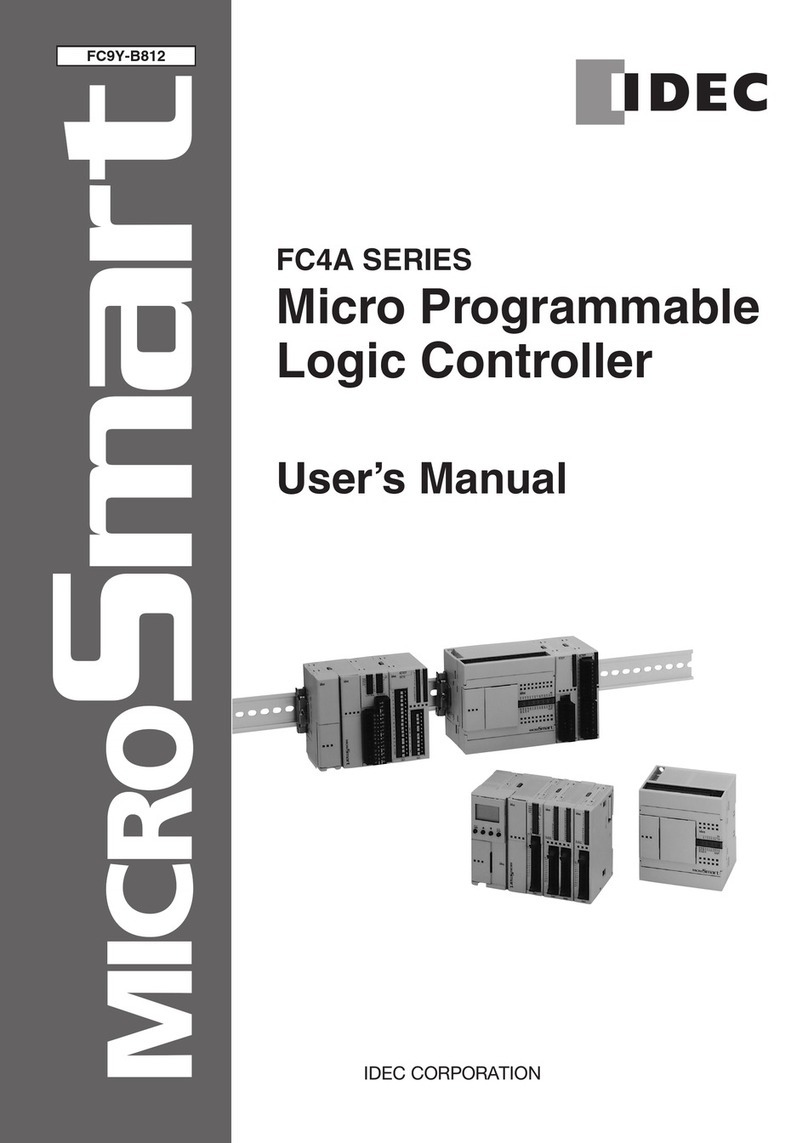
IDEC
IDEC FC4A-C10R2 User manual
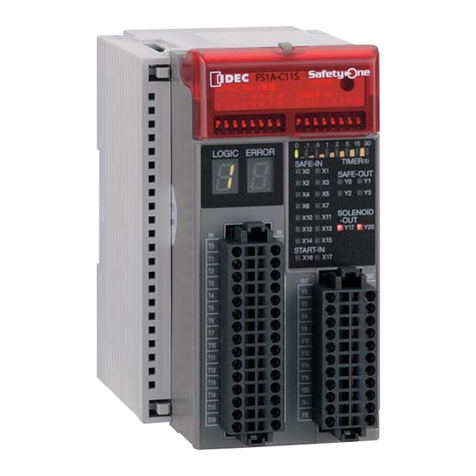
IDEC
IDEC FS1A-C11S User manual
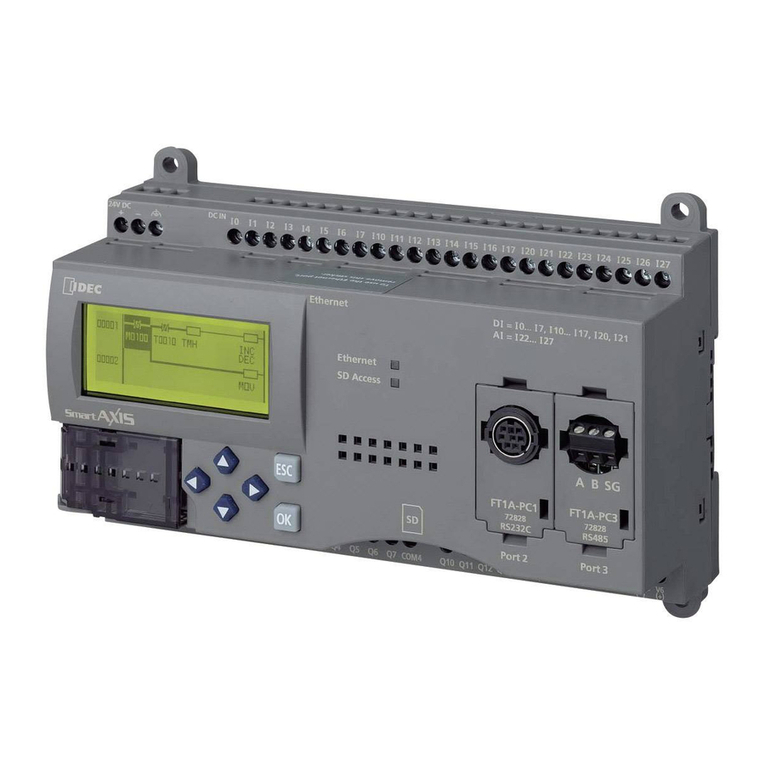
IDEC
IDEC SmartAXIS Touch FT1A Series User manual
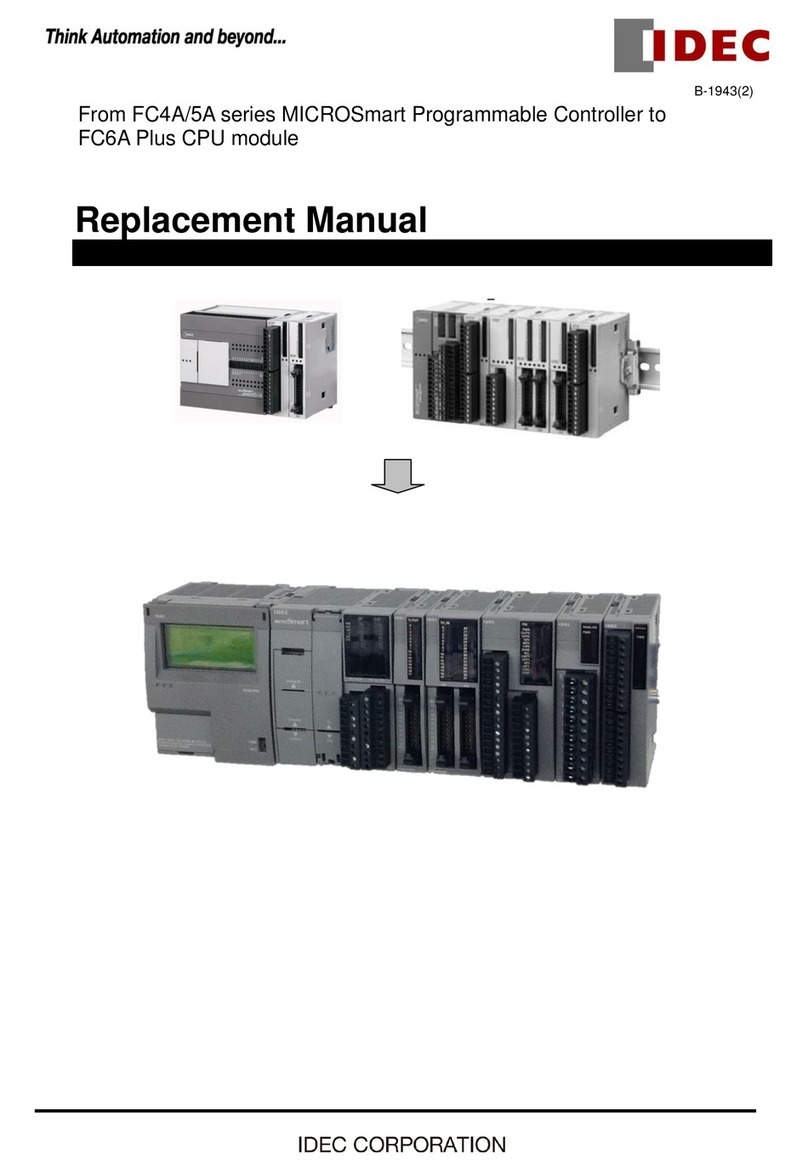
IDEC
IDEC MICROSmart FC4A Series Operating and safety instructions
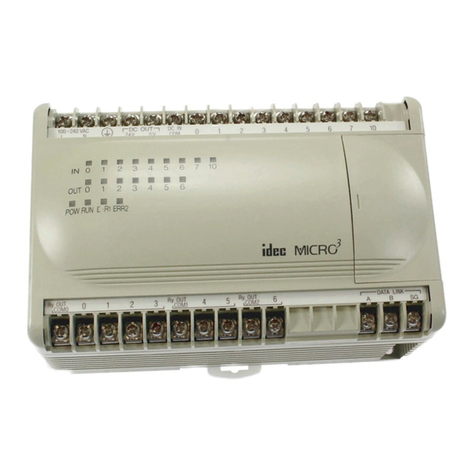
IDEC
IDEC MICRO3 User manual
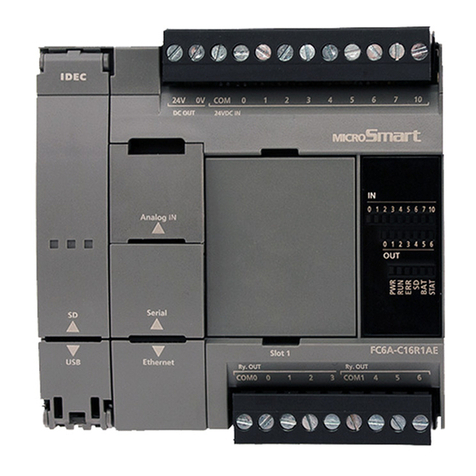
IDEC
IDEC MICROSmart FC6A Series Owner's manual
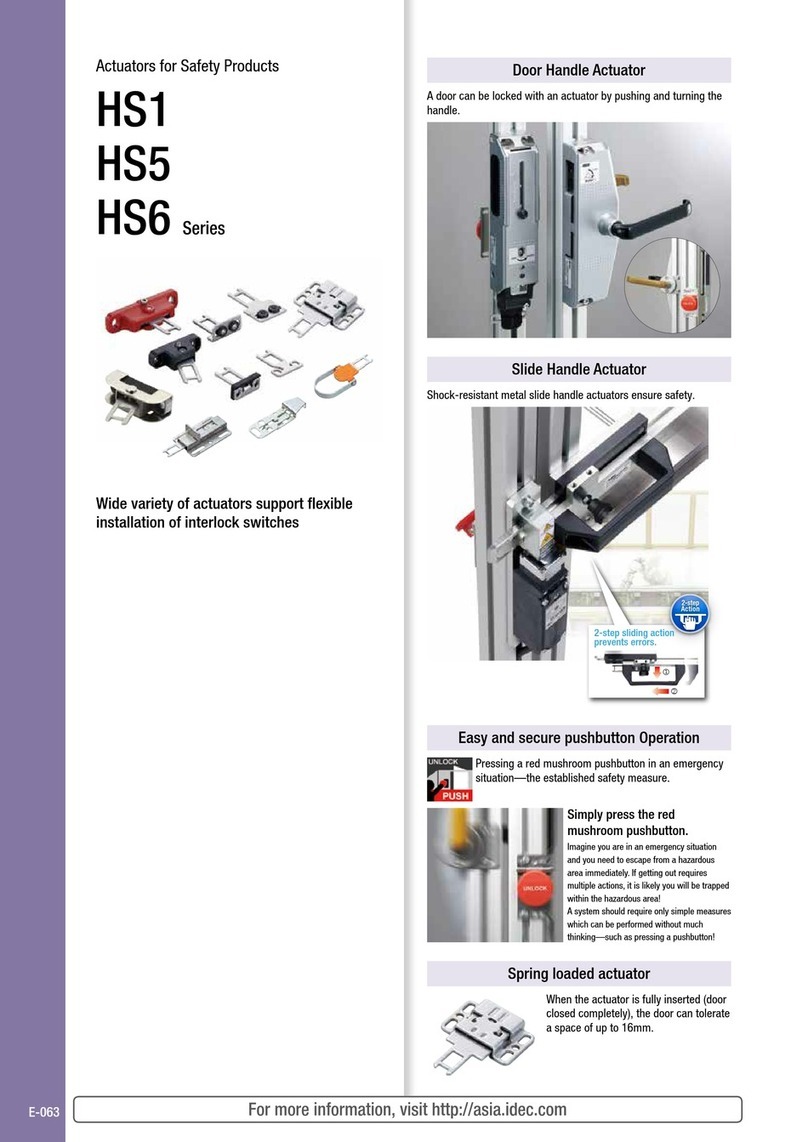
IDEC
IDEC HS1 Series User manual
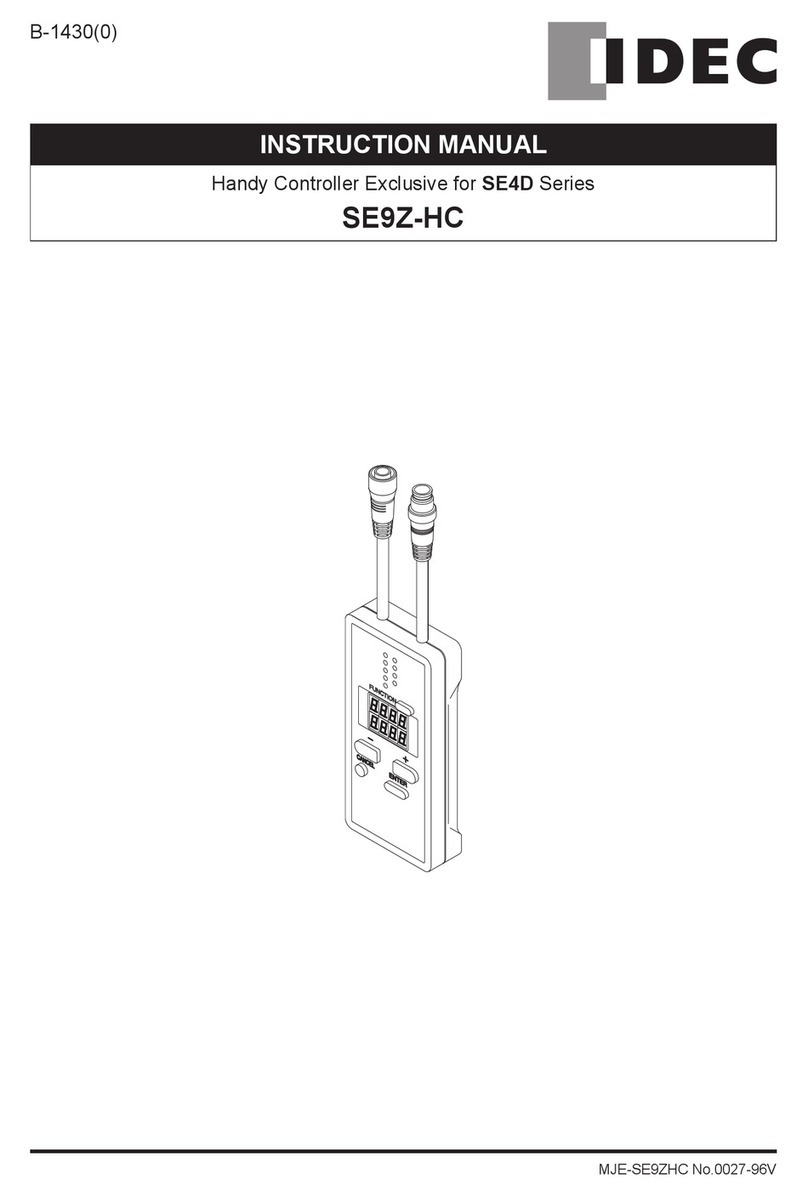
IDEC
IDEC SE9Z-HC User manual
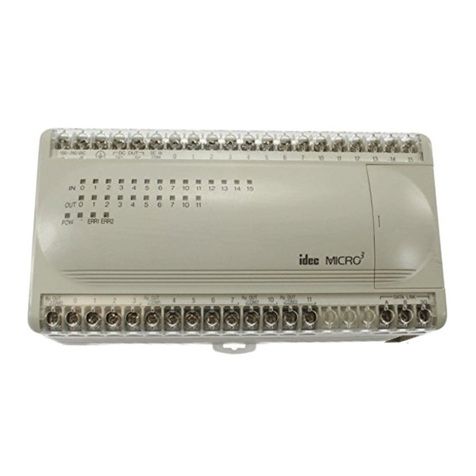
IDEC
IDEC MICRO3C User manual

IDEC
IDEC HS9Z-FL54 User manual
